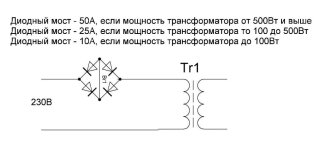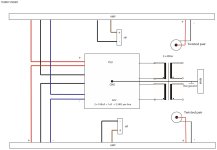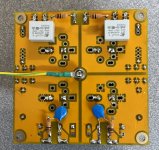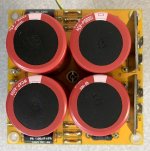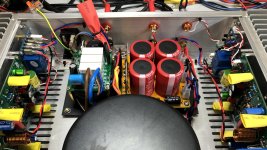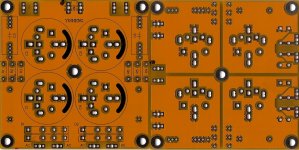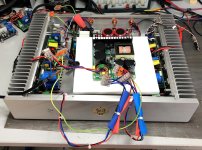Hello,
I talked about it a few posts before a few days ago. With photos and links.
The box: https://www.aliexpress.com/item/1005005050289997.html
Was purchased before prices exploded. 😈
I finished the wiring. I won't be able to listen to it tonight. Sniff. I have a ground loop when I connect the sources and the toroid resonates in its black box. Still a bit of work it seems. 😉
First time I put a transformer in a box. Do you have a technique to prevent it from making noise? It is already placed on its foam washer above and below the transformer.
Good evening.
Stef.
I talked about it a few posts before a few days ago. With photos and links.
The box: https://www.aliexpress.com/item/1005005050289997.html
Was purchased before prices exploded. 😈
I finished the wiring. I won't be able to listen to it tonight. Sniff. I have a ground loop when I connect the sources and the toroid resonates in its black box. Still a bit of work it seems. 😉
First time I put a transformer in a box. Do you have a technique to prevent it from making noise? It is already placed on its foam washer above and below the transformer.
Good evening.
Stef.
Hello,
I'm still trying to figure out where my ground loop is coming from. I connected as usual and I have a very loud hum as soon as I connect the second line input to the input RCA. I rewired while flying, simplifying as much as possible (just the power supply and the input and output connectors). I disconnected the soft start and the HP protections. It couldn't be simpler. Always the hum.
I made a wiring diagram to clarify this. At the moment, I don't understand.
Stef.
I'm still trying to figure out where my ground loop is coming from. I connected as usual and I have a very loud hum as soon as I connect the second line input to the input RCA. I rewired while flying, simplifying as much as possible (just the power supply and the input and output connectors). I disconnected the soft start and the HP protections. It couldn't be simpler. Always the hum.
I made a wiring diagram to clarify this. At the moment, I don't understand.
Stef.
Attachments
@stef1777
Review Vunce’s post #1882, particularly the pictures. Notice he has individual NTC thermistors which act as ground lifts from the PS Ground to chassis ground. He has individual ones because he has two separate power supplies. You have only 1 so you can experiment with just one thermistor or equivalent bridge rectifier, thermistor/cap combination, antiparallel diodes, etc…whatever will block any small ground current from communicating. I don‘t know if those are Prasi’s PS boards, your own design or someone else‘s. But if they are not Prasi’s then it’s important that there aren’t any shared PCB traces on the PS board. Shared PCB traces are discussed first on slide 42 and onwards In the Hifisonix grounding document linked below.
Review HifiSonix‘s document on proper grounding, particularly starting at slide 54 which can illustrate a scenario you can follow and implement. Since your RCA’s are on either side of the chassis (as most of our builds are), you may need to move them and bond the grounds.
You may need to rotate your mains transformer clockwise/anticlockwise to minimize your hum as well. If they are fully shielded and encapsulated then this is less likely to be an issue.
Remember chassis ground is at a single point in the chassis. Not multiple points.
Best,
Anand.
Review Vunce’s post #1882, particularly the pictures. Notice he has individual NTC thermistors which act as ground lifts from the PS Ground to chassis ground. He has individual ones because he has two separate power supplies. You have only 1 so you can experiment with just one thermistor or equivalent bridge rectifier, thermistor/cap combination, antiparallel diodes, etc…whatever will block any small ground current from communicating. I don‘t know if those are Prasi’s PS boards, your own design or someone else‘s. But if they are not Prasi’s then it’s important that there aren’t any shared PCB traces on the PS board. Shared PCB traces are discussed first on slide 42 and onwards In the Hifisonix grounding document linked below.
Review HifiSonix‘s document on proper grounding, particularly starting at slide 54 which can illustrate a scenario you can follow and implement. Since your RCA’s are on either side of the chassis (as most of our builds are), you may need to move them and bond the grounds.
You may need to rotate your mains transformer clockwise/anticlockwise to minimize your hum as well. If they are fully shielded and encapsulated then this is less likely to be an issue.
Remember chassis ground is at a single point in the chassis. Not multiple points.
Best,
Anand.
Last edited:
Thanks for your advice.
I'm a little dry because the topology of the wiring is the same as with the Q17-Mini and many other amps I've built. Until now, I've never had to use DIY thermistors or bridges to get rid of a hum.
The PSU PCB is the one I use most of the time. It's a Chinese PCB with which I've never had a problem. I can post you a scan of the front/back PCB if you want.
https://fr.aliexpress.com/item/1005003750120634.html
Speaker terminals, RCAs, etc. are of course isolated from the chassis (all checked). The chassis is connected to the ground at a single point (close to the power socket). I put some pictures of the finished version. The RCAs are next to each other, 3cm apart. There is always at least 2cm between the weak and strong current cables. Without RCA connected to the amp (or only one). No noise at all even ear glued to the tweater.
I tried a thermistor between the chassis/ground and the GND of the PSU. No change.
I also tried with another identical power supply but without the Saligny bridge and without the snubbers. I also tried with another stereo source. No changes.
Stef.
I'm a little dry because the topology of the wiring is the same as with the Q17-Mini and many other amps I've built. Until now, I've never had to use DIY thermistors or bridges to get rid of a hum.
The PSU PCB is the one I use most of the time. It's a Chinese PCB with which I've never had a problem. I can post you a scan of the front/back PCB if you want.
https://fr.aliexpress.com/item/1005003750120634.html
Speaker terminals, RCAs, etc. are of course isolated from the chassis (all checked). The chassis is connected to the ground at a single point (close to the power socket). I put some pictures of the finished version. The RCAs are next to each other, 3cm apart. There is always at least 2cm between the weak and strong current cables. Without RCA connected to the amp (or only one). No noise at all even ear glued to the tweater.
I tried a thermistor between the chassis/ground and the GND of the PSU. No change.
I also tried with another identical power supply but without the Saligny bridge and without the snubbers. I also tried with another stereo source. No changes.
Stef.
Attachments
Last edited:
Disconnect your input RCA’s from the source and short your inputs. Do you still get hum from your test speaker or measured on a scope? In other words, is the hum intrinsic to the amp itself or is it coming from a ground loop from your source?
Edit: You disconnected the input RCA, did the hum go away? Yes/No? If hum went away then hum is coming from your source, not the amplifier.
You are going to have to start poking around. I would connect one lead of your DMM to chassis ground and then use the other lead and test to see if anything else (that shouldn’t be) is touching ground. Sometimes it’s a screw of a standoff that moved slightly and is touching an active portion of a pcb, etc…work backwards systematically and test each pcb individually. Check the bottom of all pcb’s - make sure no leads are connecting to the chassis - it may be a weak ground, but it can and will cause problems. Are the backs of transistors that are mounted to heatsinks electrically isolated but thermally coupled?
You may need to try the ceramic disc capacitor modification for your input RCA’s mentioned in the Hifisonix document.
When you do find the solution - please post!
Best,
Anand.
Edit: You disconnected the input RCA, did the hum go away? Yes/No? If hum went away then hum is coming from your source, not the amplifier.
You are going to have to start poking around. I would connect one lead of your DMM to chassis ground and then use the other lead and test to see if anything else (that shouldn’t be) is touching ground. Sometimes it’s a screw of a standoff that moved slightly and is touching an active portion of a pcb, etc…work backwards systematically and test each pcb individually. Check the bottom of all pcb’s - make sure no leads are connecting to the chassis - it may be a weak ground, but it can and will cause problems. Are the backs of transistors that are mounted to heatsinks electrically isolated but thermally coupled?
You may need to try the ceramic disc capacitor modification for your input RCA’s mentioned in the Hifisonix document.
When you do find the solution - please post!
Best,
Anand.
Last edited:
Stef,
Install the thermistor in series with ground wire attached to the center if your psu board and chassis star ground.
If you check resistance between rca socket shield and chassis it should show the ohmic value of the thermistor. Same for speaker return. If not, you have another path to chassis ground bypassing the thermistor.
Nothing more frustrating than tracking down a ground loop, you’ll find it 😉
Install the thermistor in series with ground wire attached to the center if your psu board and chassis star ground.
If you check resistance between rca socket shield and chassis it should show the ohmic value of the thermistor. Same for speaker return. If not, you have another path to chassis ground bypassing the thermistor.
Nothing more frustrating than tracking down a ground loop, you’ll find it 😉
This Q17-Turbo broke my feet until the end. 😈
More tests.
Ground/chassis wire disconnected from PSU: no contact
RCA not connected -> no hum.
RCA with 0R plug -> no hum.
RCA shield and chassis -> 15R (thermistor).
SPK shield and chassis -> 15R (thermistor).
PSU GND (or boards) and chassis -> 15R (thermistor).
If one of the cards is not powered (green power connector disconnected), I still have the hum on the remaining channel. If I reverse, same thing with the other channel.
I will try with two power supplies to see. One will be the current transformer + psu, the second a Connex RXE 60v. I remember now that I had this problem in the past with another amp. Very strong hum and theoretically good config. It was a Chinese adaptation of the Burmester 956. I never found the problem and had to use two PSUs.
There I test the amp connected to an Airplay terminal. I also tried it with my Topping D50s. Same result. If I take two other amps (including a Q17-Mini) and plug them into the AirPlay terminal. No hum.
I'll let it rest otherwise, I'll end up making a mistake by getting angry and burning out the amp.
Stef.
EDIT: To top it off, my old Rigol generator broke down. No more signal at output. 👽
More tests.
Ground/chassis wire disconnected from PSU: no contact
RCA not connected -> no hum.
RCA with 0R plug -> no hum.
RCA shield and chassis -> 15R (thermistor).
SPK shield and chassis -> 15R (thermistor).
PSU GND (or boards) and chassis -> 15R (thermistor).
If one of the cards is not powered (green power connector disconnected), I still have the hum on the remaining channel. If I reverse, same thing with the other channel.
I will try with two power supplies to see. One will be the current transformer + psu, the second a Connex RXE 60v. I remember now that I had this problem in the past with another amp. Very strong hum and theoretically good config. It was a Chinese adaptation of the Burmester 956. I never found the problem and had to use two PSUs.
There I test the amp connected to an Airplay terminal. I also tried it with my Topping D50s. Same result. If I take two other amps (including a Q17-Mini) and plug them into the AirPlay terminal. No hum.
I'll let it rest otherwise, I'll end up making a mistake by getting angry and burning out the amp.
Stef.
EDIT: To top it off, my old Rigol generator broke down. No more signal at output. 👽
Stef, have you tried to replace the R32 strap by 10R, like in Tibi's original?
Ta panne de générateur, c'est pas Rigolo du tout (mais ça m'a quand même fait sourire).
Bonne chance.
Ta panne de générateur, c'est pas Rigolo du tout (mais ça m'a quand même fait sourire).
Bonne chance.
I moved the left twisted pair around the cabinet as in the manuals (page 62). Even worse.
I replaced the twisted pair with a shielded cable. No change.
I'll see tomorrow to try with R32 = 10R (or 15R) and get the SPK GND from the PSU instead of taking it from the board.
And finally, with two independent PSUs.
Afterwards, I would be out of ideas for the moment.
Good evening,
Stef.
I replaced the twisted pair with a shielded cable. No change.
I'll see tomorrow to try with R32 = 10R (or 15R) and get the SPK GND from the PSU instead of taking it from the board.
And finally, with two independent PSUs.
Afterwards, I would be out of ideas for the moment.
Good evening,
Stef.
Hello,
Continuation of the hum tests with the Q17-Turbo.
Get the SPK GND from the PSU instead of taking it from the board. No change at all.
Test with resistors on R32 instead of a strap.
I tried with 10R and 18R. As soon as you put a resistor, the level of the hum decreases by 80% but it is still audible. When we go from 10R to 18R, we have a small but weak drop. If we connect the GND to the chassis/ground via a 15R thermistor, we hear practically no difference. I even have the impression that the hum is even a bit louder with the thermistor.
As soon as you put a resistor, you end up with DC Offset at the output. I found 32mV on one side and 65mV on the other. I have zero offset with a strap.
So to sum up, the R32 acts as a hum killer as expected but insufficiently and introduces offset.
I still have to test with two power supplies.
Have a good day
Stef.
Continuation of the hum tests with the Q17-Turbo.
Get the SPK GND from the PSU instead of taking it from the board. No change at all.
Test with resistors on R32 instead of a strap.
I tried with 10R and 18R. As soon as you put a resistor, the level of the hum decreases by 80% but it is still audible. When we go from 10R to 18R, we have a small but weak drop. If we connect the GND to the chassis/ground via a 15R thermistor, we hear practically no difference. I even have the impression that the hum is even a bit louder with the thermistor.
As soon as you put a resistor, you end up with DC Offset at the output. I found 32mV on one side and 65mV on the other. I have zero offset with a strap.
So to sum up, the R32 acts as a hum killer as expected but insufficiently and introduces offset.
I still have to test with two power supplies.
Have a good day
Stef.
R32 is a hum breaker resistor (HBR), seen on schematic on previous page on right lower hand corner of schematic. Mentioned in the grounding document I had linked earlier from Andrew @ Hifisonix.
I also wonder if the Chinese PSU pcb follow the same guidelines as others, hence I don’t buy them! Better to just use reputable, like Prasi’s pcb designs and order from a chinese fab.
Thanks for the update!
Best,
Anand.
P.S. Hope you fix your scope!
I also wonder if the Chinese PSU pcb follow the same guidelines as others, hence I don’t buy them! Better to just use reputable, like Prasi’s pcb designs and order from a chinese fab.
Thanks for the update!
Best,
Anand.
P.S. Hope you fix your scope!
Last edited:
Hello,
The Chinese do good, very good and very bad things. Nothing more normal in such a big country.
I use this power supply in at least 4 amps (including my Q17-Mini). I never had a problem. Unfortunately I don't have any other model in stock except my Connex PSU.
I haven't found any design issues with it so far. The PCB is well made, 2mm thick and 2 Oz.
I put the scan of the PCB for your information.
I will do other tests with the PSU by changing technique. I will rebuild my "flying" dev wiring outside the box and adding the elements one after the other starting with the minimum element.
It was not my scope that stopped working but my Rigol DG1012 generator (more than 10 years old). This is the series at the moment after my Weller iron which died at the end of July.
Stef.
The Chinese do good, very good and very bad things. Nothing more normal in such a big country.
I use this power supply in at least 4 amps (including my Q17-Mini). I never had a problem. Unfortunately I don't have any other model in stock except my Connex PSU.
I haven't found any design issues with it so far. The PCB is well made, 2mm thick and 2 Oz.
I put the scan of the PCB for your information.
I will do other tests with the PSU by changing technique. I will rebuild my "flying" dev wiring outside the box and adding the elements one after the other starting with the minimum element.
It was not my scope that stopped working but my Rigol DG1012 generator (more than 10 years old). This is the series at the moment after my Weller iron which died at the end of July.
Stef.
Attachments
Sorry, didn’t mean to generalize about the Chinese. Indeed you are correct.
Maybe consider a pcb manufacturing defect. Difficult to properly test.
Best,
Anand.
Maybe consider a pcb manufacturing defect. Difficult to properly test.
Best,
Anand.
Good news !!!
NO HUM.
NO OFFSET.
I wired at least with an SMPS600RxE Connex power supply and the inputs / outputs wired directly. Nothing is used in the box. The GND is connected to ground (no thermistor). The enclosure is not grounded in this test. R32 strapped are back. It's like both boards are on the desk like when I'm developing the prototypes.
This story is crazy.
It remains to understand the error or what is the dysfunctional element.
Anyway, the Q17-Turbo boards work in stereo with only one PSU. Phew!!
It feels good to finally hear the Turbo in stereo after more than a year of development and 4 prototypes.. 🙂
Stef.
NO HUM.
NO OFFSET.
I wired at least with an SMPS600RxE Connex power supply and the inputs / outputs wired directly. Nothing is used in the box. The GND is connected to ground (no thermistor). The enclosure is not grounded in this test. R32 strapped are back. It's like both boards are on the desk like when I'm developing the prototypes.
This story is crazy.
It remains to understand the error or what is the dysfunctional element.
Anyway, the Q17-Turbo boards work in stereo with only one PSU. Phew!!
It feels good to finally hear the Turbo in stereo after more than a year of development and 4 prototypes.. 🙂
Stef.
Attachments
Last edited:
- Home
- Amplifiers
- Solid State
- Q17 - an audiophile approach to perfect sound

